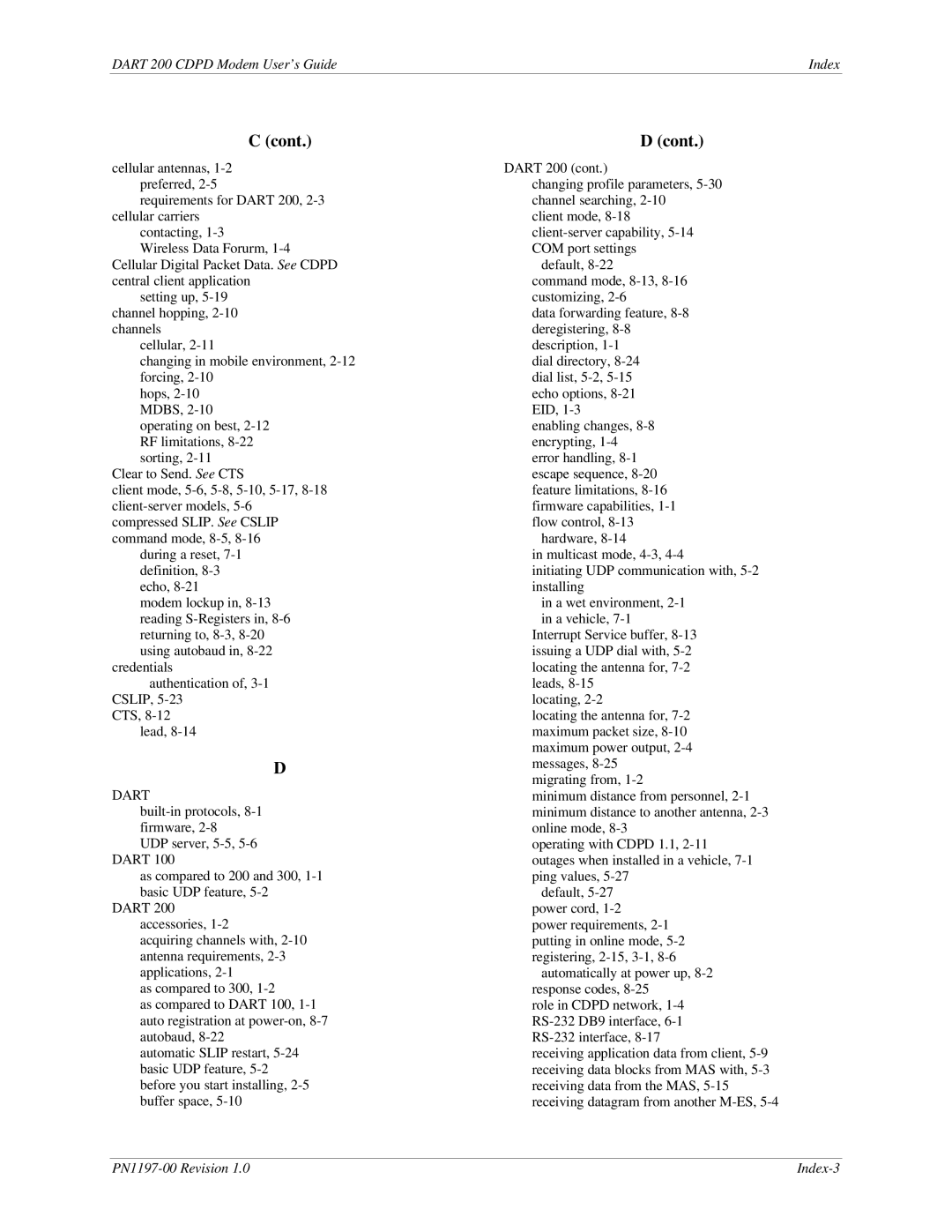C (cont.)
cellular antennas, 1-2 preferred, 2-5
requirements for DART 200, 2-3 cellular carriers
contacting, 1-3
Wireless Data Forurm, 1-4 Cellular Digital Packet Data. See CDPD central client application
setting up, 5-19 channel hopping, 2-10 channels
cellular, 2-11
changing in mobile environment, 2-12 forcing, 2-10
hops, 2-10 MDBS, 2-10 operating on best, 2-12 RF limitations, 8-22 sorting, 2-11
Clear to Send. See CTS
client mode, 5-6, 5-8, 5-10, 5-17, 8-18 client-server models, 5-6 compressed SLIP. See CSLIP command mode, 8-5, 8-16
during a reset, 7-1 definition, 8-3 echo, 8-21
modem lockup in, 8-13 reading S-Registers in, 8-6 returning to, 8-3, 8-20 using autobaud in, 8-22
credentials authentication of, 3-1
CSLIP, 5-23 CTS, 8-12
lead, 8-14
D
DART
built-in protocols, 8-1 firmware, 2-8
UDP server, 5-5, 5-6 DART 100
as compared to 200 and 300, 1-1 basic UDP feature, 5-2
DART 200 accessories, 1-2
acquiring channels with, 2-10 antenna requirements, 2-3 applications, 2-1
as compared to 300, 1-2
as compared to DART 100, 1-1 auto registration at power-on, 8-7 autobaud, 8-22
automatic SLIP restart, 5-24 basic UDP feature, 5-2 before you start installing, 2-5 buffer space, 5-10
D (cont.)
DART 200 (cont.)
changing profile parameters, 5-30 channel searching, 2-10
client mode, 8-18 client-server capability, 5-14 COM port settings
default, 8-22 command mode, 8-13, 8-16 customizing, 2-6
data forwarding feature, 8-8 deregistering, 8-8 description, 1-1
dial directory, 8-24 dial list, 5-2, 5-15 echo options, 8-21 EID, 1-3
enabling changes, 8-8 encrypting, 1-4 error handling, 8-1 escape sequence, 8-20 feature limitations, 8-16 firmware capabilities, 1-1 flow control, 8-13
hardware, 8-14
in multicast mode, 4-3, 4-4
initiating UDP communication with, 5-2 installing
in a wet environment, 2-1 in a vehicle, 7-1
Interrupt Service buffer, 8-13 issuing a UDP dial with, 5-2 locating the antenna for, 7-2 leads, 8-15
locating, 2-2
locating the antenna for, 7-2 maximum packet size, 8-10 maximum power output, 2-4 messages, 8-25 migrating from, 1-2
minimum distance from personnel, 2-1 minimum distance to another antenna, 2-3 online mode, 8-3
operating with CDPD 1.1, 2-11 outages when installed in a vehicle, 7-1 ping values, 5-27
default, 5-27 power cord, 1-2 power requirements, 2-1 putting in online mode, 5-2 registering, 2-15, 3-1, 8-6
automatically at power up, 8-2 response codes, 8-25
role in CDPD network, 1-4 RS-232 DB9 interface, 6-1 RS-232 interface, 8-17
receiving application data from client, 5-9 receiving data blocks from MAS with, 5-3 receiving data from the MAS, 5-15 receiving datagram from another M-ES, 5-4
